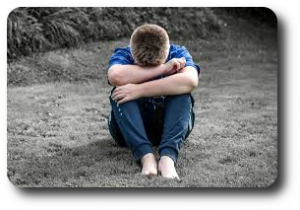The adoptive parents were worried their son could be overwhelmed by shame, if they informed supporters of his violent assaults on his mother, and these people challenged him. Yet, at the same time, the parents felt isolated, cut off, completely alone with the problem. What could I say to them?
 Shame can be an enormous problem for children, adolescents or adults who have experienced abuse. Parents and caregivers of traumatised children often experience their own victim shame, when these children target them with violence, or behave in other harmful or self-destructive ways. This is especially the case, when they fear others – members of the larger family, the community or professionals – pointing a finger at them. Amanda Holt has shown in her research, that parents of violent adolescents fear being blamed for it – parent blaming becomes victim blaming – , and we hear the same from parents, adoptive parents and foster carers when we work with them in therapy.
Shame can be an enormous problem for children, adolescents or adults who have experienced abuse. Parents and caregivers of traumatised children often experience their own victim shame, when these children target them with violence, or behave in other harmful or self-destructive ways. This is especially the case, when they fear others – members of the larger family, the community or professionals – pointing a finger at them. Amanda Holt has shown in her research, that parents of violent adolescents fear being blamed for it – parent blaming becomes victim blaming – , and we hear the same from parents, adoptive parents and foster carers when we work with them in therapy.
With young people who have abuse histories and act aggressively, adults often do not so much see them express shame; instead, they generally believe the child must be feeling shame ‘underneath’. What they actually see is behaviour that is seriously harmful to people around the child, and to the child themselves. Indeed, I often hear remarks by parents, teachers, foster carers and others that the child acted ‘shamelessly’, and showed ‘no remorse’ (the latter seeming to indicate that the child is not showing they feel guilty for what they have done). There seems to be a lot of confusion around shame. Parents may ask themselves: Is the child always ashamed ‘underneath’, when showing aggression? Are all aggressive acts the result of shame (even though we can’t actually see the shame?) Do I have to keep violence private as a parent, so as to protect my child from shame? What if keeping the violence private keeps us as parents from getting the kind of support we need? What if it feels like keeping the silence in domestic violence, and makes us more vulnerable to further abuse?
Some of this confusion can be dealt with by pointing out that violence in a person does not have to have just one ‘root cause’. Stanley Milgram and Phillip Zimbardo’s research in the 1960ies and 1970ies showed us that we grossly underestimate the impact of factors outside of the person, when it comes to acting violently. In Milgram’s famous experiment, which has been repeated many times and in many different ways, a majority of normal people (not even necessarily people who have experienced abuse or neglect themselves) would have delivered painful or potentially fatal electric shocks to someone they believed to be in the adjacent room, simply in response to the commands of a fake ‘experimenter’ who appeared to have authority and told them to keep increasing the voltage. Phillip Zimbardo created a role play on the grounds of Stanford University, in which students who were playing ‘prison guards’ supervised other students who were incarcerated and acting as ‘prisoners’. All participants in this experiment were students who had been randomly assigned to these two groups, and who in psychological tests fell into the normal range for personality factors. The ‘guards’ were only loosely supervised and given very few rules for their own behaviour, apart from being forbidden to physically assault their fellow students. Within a few days, the ‘guards’ became exceptionally cruel, and the ‘prisoners’ developed severe symptoms of mental ill health. Obviously, people do not have to have histories of early childhood trauma in order to become abusive, and responses by others around them who do not interfere and act to protect the victim are an important factor in enabling harmful behaviour (the so-called ‘bystander effect’). So, when working with the adoptive parents I am seeing in therapy – let’s call them Jill and Howard- I am eager to point out that not all of their child’s aggressive behaviour has to have trauma at its root – and that if others around the family fail to interfere and act protectively towards his mother, he may take this as permission to attack her.
What is then the difference between not keeping aggression private to the family, foster family or children’s home, and shaming the child? Is there a difference? In my view, and in my personal experience – I was often threatened with shaming as a child, and told I should be ashamed – shaming is an aggressive act. The adult wants to hurt or punish the child by pointing a finger, and getting other adults to point a finger. Eliciting feelings of shame becomes the device of hurt – the process whereby adults communicate their awareness of the young person’s wrongdoing becomes weaponised. Jill and Howard rightly wish to protect their son from such aggressive communication. This can be very different from allowing a person to experience the shame that emerges within them as a natural consequence of their action.
What does it tell us that their adoptive son – let’s call him Rex – does not appear ever to show shame, when he has -repeatedly- attacked his mother, and thereby has acted in a way that the community around the family would disapprove of, if they were aware of it? It may be the case that Rex has become so afraid of feeling ashamed, that he has built a wall against this emotion within himself. It may also be that he believes his parents will keep the nature and extent of his violent behaviour private. He may have become as phobic to feeling shame, as other people can be phobic to spiders, snakes or enclosed spaces. He has not yet learned to deal with the challenge of processing shame within himself – with the help of others. Children must learn to deal with shame as they become more acutely aware of being observed by others around them, as they become more socially self-conscious. Rex has not yet mastered this developmental task – and it may be that his early childhood history of trauma has made it more difficult for him to step up to the challenge. His parents, who have come to believe that ‘shame’ is a ‘bad emotion’, have been protecting him from shame for a very long time. If shame is a problem, it is not a good idea to help a young person avoid shame. Problems are not solved with avoidance; they get worse over time.
There is no such thing as a ‘bad emotion’. Every emotion has its purpose, and in the right place and at the right time is essential for the  survival of the individual, the group, and the individual in the group. Uri Weinblatt has written about different processes relating to shame, and the role of shame in Non Violent Resistance (NVR). He points out that constructive shame is essential for a person’s development. I, for one, am glad that I am capable of feeling and expressing shame; the gaze upon my problematic behaviour, which I see, feel and hear about, heightens my awareness that I have acted in a way that does not represent who I wish to be. This self-awareness enables me to reflect upon my action, my motives, my impact on others around me, what I may feel (rightly) guilty of, commit to changing my behaviour, and possibly seek solutions to any difficulties that may have contributed to acting in a way that I am not proud of. For others around me, my authentic expression of shame – and if I feel guilt, authentic expression of guilt – help to repair the rupture in the relationship that my behaviour has caused. Shame – while being a socially triggered emotion – has become a deterrent within myself against certain behaviours that are inconsistent with who, and with how I want to be as a person. Of course, I am not overwhelmed by this feeling. As with any emotion that is properly processed, it emerges within, waxes, takes on different forms, conjures up different thoughts and different sensations within my body, leads me to act in certain ways by correcting my behaviour and showing others that I am changing how I act – and it wanes. If properly processed, I will have learned something about myself, and about others around me whose wellbeing matters to me.
survival of the individual, the group, and the individual in the group. Uri Weinblatt has written about different processes relating to shame, and the role of shame in Non Violent Resistance (NVR). He points out that constructive shame is essential for a person’s development. I, for one, am glad that I am capable of feeling and expressing shame; the gaze upon my problematic behaviour, which I see, feel and hear about, heightens my awareness that I have acted in a way that does not represent who I wish to be. This self-awareness enables me to reflect upon my action, my motives, my impact on others around me, what I may feel (rightly) guilty of, commit to changing my behaviour, and possibly seek solutions to any difficulties that may have contributed to acting in a way that I am not proud of. For others around me, my authentic expression of shame – and if I feel guilt, authentic expression of guilt – help to repair the rupture in the relationship that my behaviour has caused. Shame – while being a socially triggered emotion – has become a deterrent within myself against certain behaviours that are inconsistent with who, and with how I want to be as a person. Of course, I am not overwhelmed by this feeling. As with any emotion that is properly processed, it emerges within, waxes, takes on different forms, conjures up different thoughts and different sensations within my body, leads me to act in certain ways by correcting my behaviour and showing others that I am changing how I act – and it wanes. If properly processed, I will have learned something about myself, and about others around me whose wellbeing matters to me.
Rex does not yet know how to do this. He has ruptured relationships with others who are close to him – especially his adoptive parents – so often, that it has become a way of life. In Rex’ life, rupture leads to further rupture, not to repair, and Rex does not seem to feel either shame or guilt for what he does that hurts others. He does try to harmonise, act as if nothing had happened, and expects his parents to act like nothing has happened – though it must take a lot of emotional effort to ‘overlook’, that they are still upset, hurt or maybe avoid him in spite of playing along with the folly that everything is already fine between them, while nothing has been resolved. Yet, on some level, he will pick up their difficult feelings, perhaps an initial reluctance to engage with him, perhaps fear he might become aggressive again when his parents ‘walk on eggshells’ – and feel rejected, though they do not wish to reject him. He will also feel rejected, when other young people at school do not socialise with him, or when he gets excluded from lessons. He needs to become able to process shame if he is to become able to make authentic relational repair.
But how do Howard and Jill protect Jill from remaining vulnerable to Rex’ violence, and at the same time enable him to experience and process constructive shame? For one, his parents must become aware of their own motives for no longer keeping the violent behaviour private. If it is revenge or punishment, they would engage in shaming, an aggressive act. If however their motivation is protection of Jill from harm through violence, and ‘bringing Rex back’ into the family and community, helping him reconnect by changing his behaviour and repairing the relational rupture, and if they can find in themselves how they value him as a person and as their son, then they are enabling him to experience constructive shame.
Adults inadvertently help young people deal with shame. I have a vivid memory of a good friend of mine warmly laying a hand on my son’s shoulder at a moment in which he felt ashamed, smiling kindly. When another son of mine had done something shameful, I remember a relative telling him what an important role model he is for his younger cousin. Respectful behaviour towards the young person, appreciation of them as a person, and a compassionate response all help to bear the shame which is an inevitable occurrence at some points in life. When you can bear shame, you can process it. In NVR, we coach not only parents, but also those who become their supporters, to communicate in such ways that can hold and contain the young person, while at the same time telling the child that they know what he has done, and that it must stop.
We also engage parents or other adults to support the young person in making reparation to those they have harmed. This may take the form of a restorative meeting, or doing as much as possible to repair the damage that has been done – e.g. seriously and sincerely apologising to someone who has been humiliated in front of those who witnessed the humiliation. In this way, the young person is not alone when they face their own shame, but actually experience their parents’ support in getting through and overcoming what is one of life’s serious challenges. In doing so, the adults help to open the door for the young person to be accepted once again, by other young people, by teachers, by members of the community, by their own parents. They help the child belong again – and empower him to learn how to achieve such re-connection.
I would like Jill and Howard to feel they are no longer alone. I would like Jill to know that the watchful eyes and ears of a supportive community around them will do their best to ensure her safety, and tell her son that she has a right to be treated non-violently and with respect. I would like Rex’ adoptive parents to feel that their supporters appreciate Rex and are emotionally safe for him. I would like them to feel empowered by supporting Rex to face his ‘demons’. I would like Rex to know that the adults around the family care about him as they care about his parents. I would like Rex to know he has the power to re-connect with others, to know he belongs.
This is what I said to the adoptive parents who were worried their son might become overwhelmed by shame.

By Dr. Peter Jakob
Consultant Clinical Psychologist & Systemic Family Therapist
Director PartnershipProjects
NVR is a highly effective, innovative systemic approach to the violent, harmful and self-destructive behaviour in young people. NVR is ideally suited for working within Social Services and Education environments. More here…
